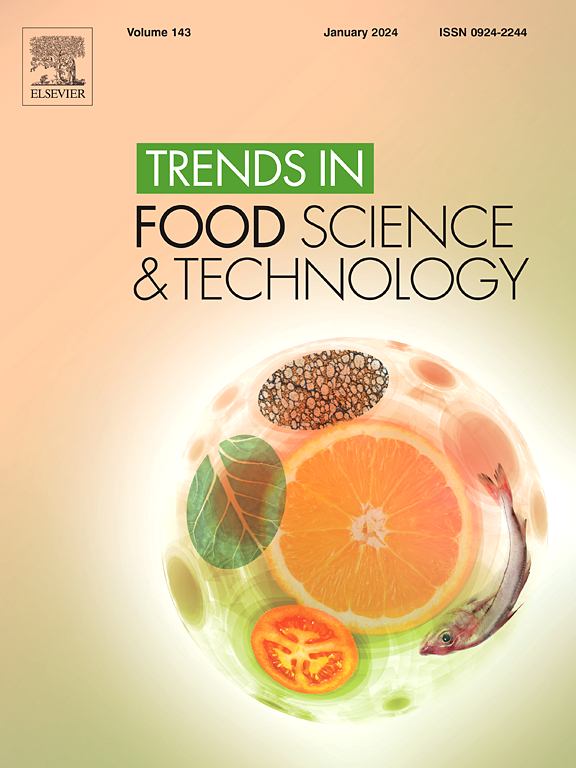Hydrothermal extraction of bioactives and biopolymers assisted by eutectic mixtures as modifier
IF 15.1
1区 农林科学
Q1 FOOD SCIENCE & TECHNOLOGY
引用次数: 0
Abstract
Background
Among the green technologies for the extraction of botanical bioactives with food applications, the use of both pressurized hot water under subcritical conditions and eutectic mixtures of natural compounds are highly promising. The performance of pressurized hot water extraction can be enhanced by the incorporation of modifiers and the controlled addition of water to eutectic mixtures facilitates operation, especially with continuous solvent flow operation. Based on these two facts, the combination of natural eutectic solvents (NaDES), with pressurized hot water, conforms a relatively recent approach for the extraction of bioactives and biopolymers from agricultural and food waste biomass.
Scope and approach
The NaDES assisted pressurized hot water has especial interest for the extraction of increasingly demanded bioactives for the formulation of functional foods and nutraceuticals from widely available low cost sources, such as agro-food wastes. The effect of the most influencing operational conditions and the until now few reported applications to efficiently extract bioactives and biopolymers from different underused biomass are overviewed.
Key findings and conclusions
This approach joins the advantages of both green techniques, offering the possibility of using wet biomass, avoiding drying stages, in a tunable process providing enhanced properties and stability of bioactives. The preparation of ready to use biopolymers and bioactives is feasible without requiring the costly stages for solute separation and for eutectic solvent recovery. Further studies are encouraged to address the major challenges in this field, including tools for the rational selection of solvents and operational conditions, advances in the knowledge of extraction mechanisms, solvent and solute recovery, scaling up, potential commercial applications and safety issues, particularly for food uses.
用共晶混合物作为改性剂辅助水热萃取生物活性物质和生物聚合物
在食品中提取植物生物活性物质的绿色技术中,亚临界条件下的加压热水和天然化合物的共晶混合物的使用是非常有前途的。通过加入改性剂可以提高加压热水萃取的性能,并且在共晶混合物中控制加水方便操作,特别是在连续溶剂流动操作时。基于这两个事实,将天然共晶溶剂(NaDES)与加压热水相结合,符合从农业和食物垃圾生物质中提取生物活性物质和生物聚合物的一种相对较新的方法。范围和方法NaDES辅助的加压热水对从广泛可用的低成本来源(如农业食品废弃物)中提取功能性食品和营养保健品配方中日益需要的生物活性物质特别感兴趣。综述了影响最大的操作条件的影响以及迄今为止很少报道的从不同未充分利用的生物质中有效提取生物活性物质和生物聚合物的应用。该方法结合了两种绿色技术的优点,提供了使用湿生物质的可能性,避免了干燥阶段,在可调的过程中提供了增强的特性和生物活性的稳定性。制备现成的生物聚合物和生物活性物是可行的,而不需要昂贵的溶质分离和共晶溶剂回收阶段。鼓励进一步研究以解决这一领域的主要挑战,包括合理选择溶剂和操作条件的工具,萃取机制知识的进步,溶剂和溶质回收,扩大规模,潜在的商业应用和安全问题,特别是食品用途。
本文章由计算机程序翻译,如有差异,请以英文原文为准。
求助全文
约1分钟内获得全文
求助全文
来源期刊

Trends in Food Science & Technology
工程技术-食品科技
CiteScore
32.50
自引率
2.60%
发文量
322
审稿时长
37 days
期刊介绍:
Trends in Food Science & Technology is a prestigious international journal that specializes in peer-reviewed articles covering the latest advancements in technology, food science, and human nutrition. It serves as a bridge between specialized primary journals and general trade magazines, providing readable and scientifically rigorous reviews and commentaries on current research developments and their potential applications in the food industry.
Unlike traditional journals, Trends in Food Science & Technology does not publish original research papers. Instead, it focuses on critical and comprehensive reviews to offer valuable insights for professionals in the field. By bringing together cutting-edge research and industry applications, this journal plays a vital role in disseminating knowledge and facilitating advancements in the food science and technology sector.
 求助内容:
求助内容: 应助结果提醒方式:
应助结果提醒方式:


